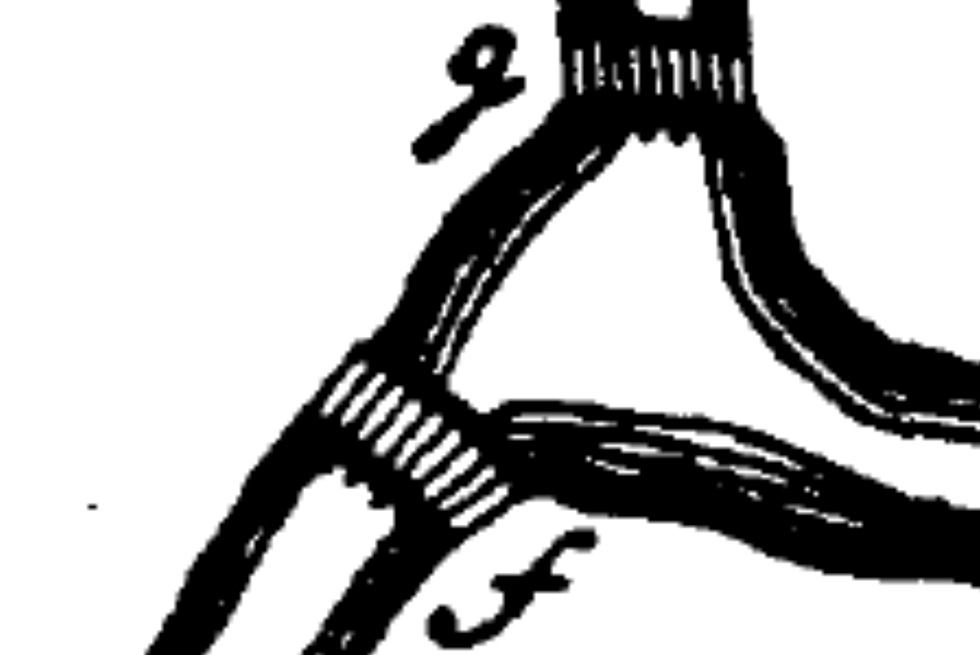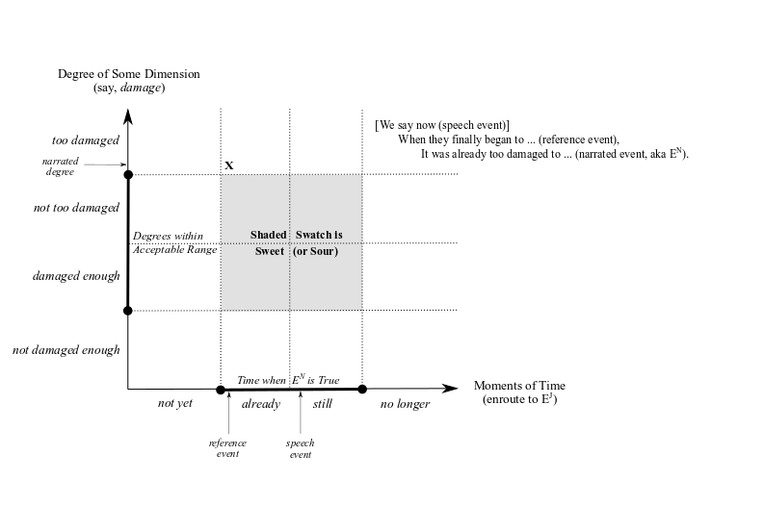Threshold
From the Series: Topology as Method
From the Series: Topology as Method

At the end of July, there was no longer enough water for all the trees.
Despite the evidence they had seen, they were not yet angry enough to take a stand.
When they finally began to act, it was already too damaged to make a difference.
While these three judgments involve different lexical contents, they express similar grammatical patterns. Taken together, as a poem as much as a prophecy, they evince the kind of invariance under variation that is a hallmark of topological inquiry.
Each of these judgments involves three events, or intervals. Focusing on the third judgment, there is the time the judgment was made (the speech event), the time someone began to act (the reference event), and the time something was too damaged to make a difference (the narrated event).
Focusing on the second clause of this third judgment, the referent of “it” is the figure (say, the planet Earth, itself the ur-ground for an infinity of other figures). The referent of “damaged” is the dimension (say, some generalized notion of harm or degradation that can occur to greater or lesser degrees of intensity).
An adverb like “too” indicates that the degree of the dimension at issue, for the figure in question, is outside of some acceptable range. Crucially, such a range is dependent not just on the figure and dimension in question, but also on the stance of the speaker and the standards of some collectivity (where such standards and stances are themselves dependent on some causal model of the world, and/or some intensity imaginary more generally).
An adverb like “already,” as in the second clause, indicates that the onset of too much damage occurred before the time of action. Such an adverb, then, relates the reference event and the narrated event (onset or offset, before or after), just like the tense (or modality) of the first clause relates the speech event and the reference event (earlier or later, actual or counterfactual).

Figure 1 shows a salient portion of the possibility space of such judgments, and is thus applicable to a wide range of figures, dimensions, events (reference, speech, narrated), stances, standards, collectivities, models, and imaginaries. Indeed, somewhat eerily, across this incredibly wide range of (possibly) possible worlds, while such a diagram might be stretched and strained indefinitely (much like a rubber sheet), the relations between relations it showcases remain relatively invariant.
The vertical axis shows the degrees of some dimension, or the intensity of some phenomenon, from lesser to greater. The thicker part of the vertical axis indicates those degrees (of the dimension at issue) that are within an acceptable range (for the figure in question). Loosely speaking, degrees below the acceptable range are less than necessary (obligatory or desirable); whereas degrees above this range are more than possible (permissible or desirable). Depending on where a degree lies (along a salient dimension, for a given figure, given some standard, from some stance, and so forth), the adverbs shown on the left of the vertical axis are differentially applicable.
The horizontal axis shows moments in time, from earlier to later. The thicker part of the horizontal axis indicates those moments of time when the judgment is being treated as true: some figure has a certain degree of some dimension (as located in relation to an acceptable range). Depending on where the reference event falls along this axis, the adverbs shown on the bottom of the horizontal axis are differentially applicable. Moreover, just as the reference event can fall within or outside of this range, the speech event can occur more or less before or after the reference event (assuming the later is actualized).
Black circles denote critical thresholds, either temporal (horizontal axis) or intensive (vertical axis).
(Note that not all 16 [= 4 x 4] possible judgments exist for all dimensions, at all moments. For example, there are many today who would claim that you can be “too rich.” And predications like “no longer dead” only make sense in a world where resurrections are possible [or zombies are actual]. Precisely what constrains this possibility space is an open, labile, and somewhat unsettling question.)
While the possibility space of such judgments is here explicated in terms of linguistic categories, similar interpretive grounds arguably exist as affective attunements, engenomed instincts, ethical standards, embodied practices, institutional arrangements, infrastructural layouts, commodity aesthetics, design features, ecological feedback mechanisms, and computational algorithms. What is too high a temperature for a coral reef? Not enough promise for a speculative investment? Too steep a slope for a wheelchair ramp? Not enough hunger for a humanitarian intervention?
Dimensions, figures, acceptability ranges, truth conditions, salient events, and so forth are incredibly wide and far-reaching. In some sense, each collectivity, and individual within such a collectivity, may have a different ensemble. Part of what it means to belong to a collectivity is to take up residence in such a space, and to represent the spaces that other collectivities reside in. Indeed, no small part of one’s identity is one’s imaginary of acceptable degrees (for various dimensions). For example, what kinds of subjects believe that it is still too early to tell, or feel that it is already too late to act? What are the conditions of possibility for such modes of subjectivity?
(Our judgments are not just sensitive to thresholds within such imaginaries, they can also function to set such thresholds. Moreover, such judgments not only conform to the world, they also transform the world, perturbing it in ways that can cause it to become both more and less iconic to their own contents.)
That said, the earth itself will set, or has set, certain essential dimensions, acceptability ranges, and reference events. To some degree, along certain key dimensions, it is arguably indifferent to our collective imaginaries. Indeed, some say that it is not just subject to our judgments, it is also a kind of ultimate agent: that which will one day judge—if it hasn’t done so already—the soundness of our judgments.